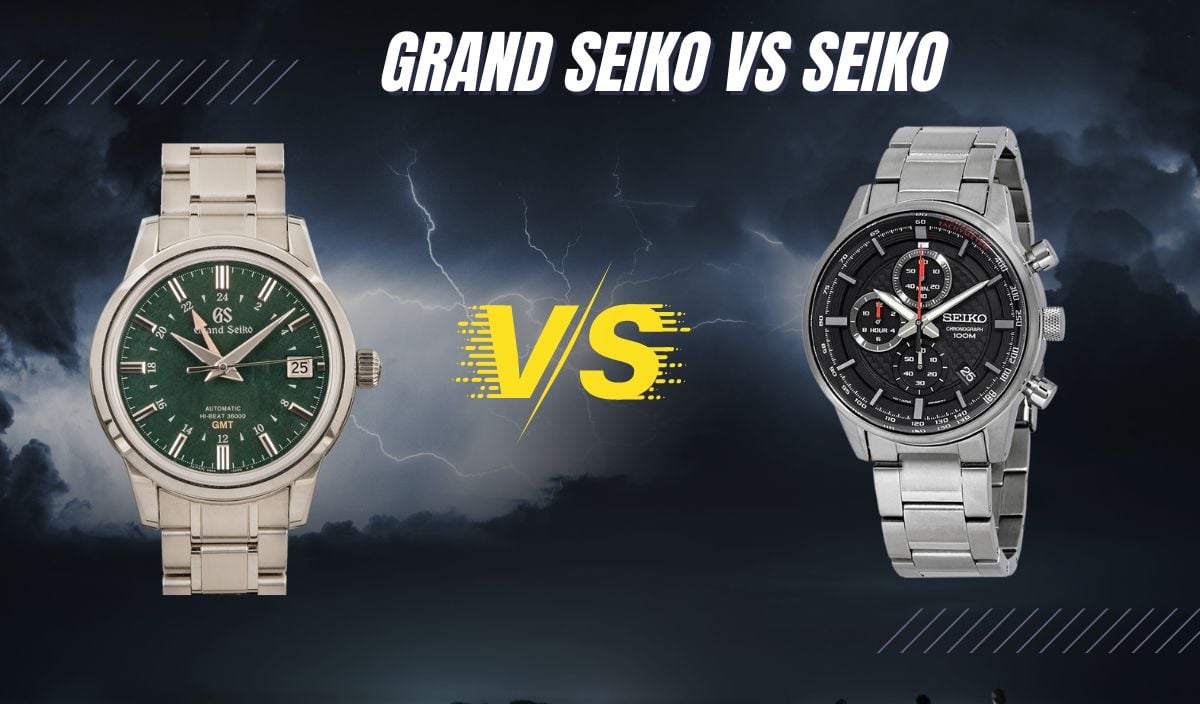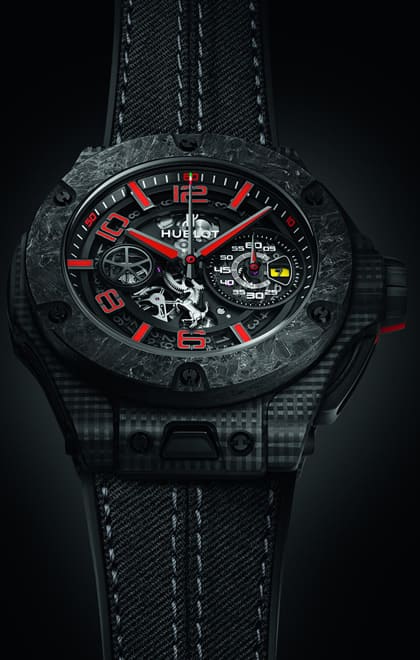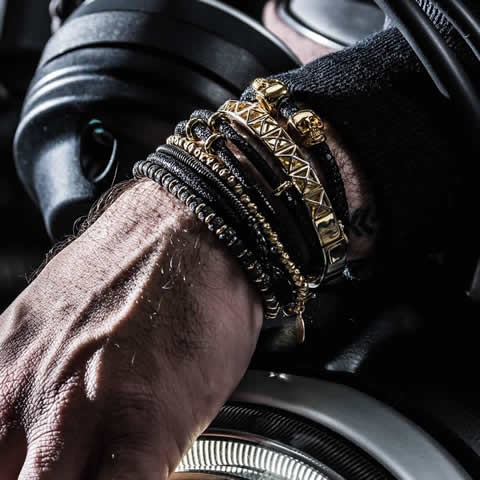
Grand Seiko vs. Seiko Watches [And the HUGE Price Gap]
You would be forgiven to think that Grand Seiko and Seiko are the same watches. Seiko is a popular brand but many people confuse it with the watch’s big brother – the Grand Seiko. Seiko watches have the reputation of being reliable, durable, and affordable. They are the watches to go for when looking for a quality and luxurious watch on a budget.
People who have been fortunate to come across both Grand Seiko and Seiko watches understand that although the two watches may look similar, there is a world of difference between them. The Grand Seiko came to cement Seiko’s place as a solid luxury watchmaker that commands the industry’s respect while still producing affordable watches. It is no shock then that the Grand Seiko is ten times more expensive than a normal Seiko (such as the Presage).
The lingering question here is: Why? What makes the Grand Seiko so unique? What is the difference between this watch and a Seiko watch you can grab off a street vendor for a few hundred bucks? This is what we seek to demystify here. Read on to learn the difference between the Grand Seiko and the Seiko watch so that you can make an informed decision the next time you think of buying a watch from the Seiko Company.
Seiko as a company – brief history
Before we compare the two watches, let us explore more about the company that manufactures these incredible watches. Seiko is among the oldest watchmaking companies in the world. The company traces its root to Tokyo, Japan, when Kintaro Hattori, a 21-year-old entrepreneur opened a shop selling watches in 1881. The company started producing and selling wall clocks before evolving into the production of pocket watches in 1895.
Kintaro was inspired to start the watchmaking company by the abandonment of the old ways of timekeeping in Japan. People needed a more reliable and accurate way of keeping time.
The pocket watches from Seiko paved the way for the production of the first wristwatch – the Seiko Laurel – in 1913. The first Seiko watch was produced in 1924 under the brand name ‘Seikosha’.
It was an instant hit and this was the watch that would shape the company’s heritage and establish dominance in the watchmaking industry. Over time, after a lot of improvements on the Seikosha watch, the first Grand Seiko model was manufactured in 1960. This was the company’s signature piece and it cemented Seiko’s place as a premium watchmaker.
Other models were released over the years, including Japan’s first wristwatch to have a stopwatch in 1964, and the first Japanese Diver’s watch in 1965. For over a century Seiko has continued to rebrand itself, adopting emerging technology to create fascinating timepieces that resonate with the masses. In 2017, Grand Seiko became an independent brand, setting itself apart from the company to mark its uniqueness and superiority as the best Seiko watch model.
As an independent brand, the Grand Seiko was able to penetrate other markets beyond Japan and establish itself as one of the best and among the most affordable luxury watches one can buy.
In the ensuing paragraphs, we shall compare the two watches deeply to understand what makes the Grand Seiko unique and more pricey than the Seiko watch.
Which watch should I go for – Seiko or grand Seiko?
Seiko creates watches that match almost every customer segment. Whether you can afford a Seiko or Grand Seiko, you will be proud to own either. The price point is what will eventually determine which watch you go for. But do not be fooled. There are distinct differences between a Seiko watch that you can purchase for several hundred dollars and a Grand Seiko that commands thousands of dollars.
Comparison of Grand Seiko and Seiko Movements
The Grand Seiko uses spring drive technology. The spring drive technology revolutionalized the watchmaking industry, placing Seiko on the same level as its competitors – The Swiss luxury watchmakers. This technology was invented by Yoshikazu Akahane, one of the world’s highly skilled watchmakers, in 1977. His main goal was to combine the best system from a quartz watch and a mechanical watch and create a unique product.
History tip: To understand how spring drive watches work, let’s quickly explore the evolution of watchmaking. The first batch of watches made in the mid-20th century were mechanical watches. These watches utilized a system where the movements inside worked through a distribution of stored energy via a gear train.
The main spring (located inside a barrel in the watch) was wound to coil tightly and then with the help of the barrel it could pass small releases of energy through the unwinding process. Despite the obvious advantage of not needing an external power source to keep this watch working, any disturbance to the oscillation (temperature, friction, etc) could make the watch gain or lose time easily.
In 1969, Seiko came up with the quartz-powered watch. This battery-powered device solved the limitations contained in mechanical watches. The quartz watches were more accurate than mechanical watches and they could be manufactured en masse easily. A simple quartz watch could outperform an expensive mechanical watch.
The spring drive technology idea came to tap into the super accuracy of the quartz watch with the endless power supply of the mechanical watch. 28 years later and with over 600 prototypes, the first batch of spring-drive watches was available for sale to the public in 2005.
Similar to mechanical watches, the spring drive is powered by the uncoiling of the mainspring that gradually releases energy. However, instead of the typical escapement, these watches have a revolutionary tri-synchro regulator component installed.
The tri-synchro regulator does 3 functions;
- It helps to control the release of energy from the mainspring
- It assists in the conversion of the mechanical power from the mainspring to electrical power energy to the quartz
- It generates a magnetic force to act as a frictionless brake to ensure accuracy in timekeeping
The electrical charge generated in the glide wheel is sent to the quartz crystal to create a vibration and then sent back to the integrated circuit. Instead of the constant locking and unlocking mechanism found in a quartz watch, we get a quartz oscillation frequency. Free rotation of the glide wheel allows for the beautiful movement of the second hand. The hand seems as if it is floating.
Quality, style, and build of Seiko Vs Grand Seiko
When you place the Seiko watch and the Grand Seiko watches side by side, you will notice several craftsmanship differences. The Seiko watch was designed to be an incredibly accurate yet affordable timepiece but it has nothing over the Grand Seiko. The casing does not have the luxurious look or feel of the Grand Seiko. We shall explore these structural differences between the two watches briefly in the preceding paragraphs.
Grand Seiko watch parts are handmade
There is a certain level of sophistication that comes with creating a product by hand versus using a machine. Seiko watches may be reliable but the company does not put much effort (or money) into designing these watches. And the price point reflects this. You can pick a Seiko watch for approximately $500 from a street vendor.
Grand Seiko world watches demand a higher price point (with some selling for over $15,000 a piece). Why the huge price variation? Many components of the Grand Seiko watches are made by hand. Japanese watchmakers have an unrivaled reputation for being legends in their business.
It is not uncommon to find a person working on a single watch component for over a decade. Combine several experts, each with a ton of knowledge and understanding of how a particular component works, and what you get in the end is a masterpiece. The devotion that goes into making every component of a Grand Seiko watch is astonishing.
The Grand Seiko case and bracelets are well-polished
In some instances, both Seiko watch models are made from stainless steel. The difference is that the Grand Seiko watch is made from a higher-quality stainless steel material. In other cases (such as in the creation of custom pieces) higher-quality materials – such as titanium and platinum- are used.
Although stainless steel is the standard material used by almost every watchmaker to design cases, you can instantly tell there is a big difference in the quality of the material used on a Seiko and a Grand Seiko.
when you place the watches side by side. The Grand Seiko SBGA211 watch, for instance, has a high-intensity titanium case. It has a diameter of 41mm, a lug-to-lug distance of 49mm, and a thickness of 12.5mm. The back of the watch is made of a see-through, screw-back case with dual-curved sapphire glass and an anti-reflective coating on the inner surface.
This titanium case is highly polished to deliver a mirror-like finish and to create beautiful, sharply defined edges. For comparison, the Seiko SARY 147 has a diameter of 38.3mm, a lug-to-lug distance of 43.6mm, and a thickness of 11.2mm. It is a mechanical watch with a stainless steel case and a beautiful texture. The second timer is painted blue, unlike in the Grand Seiko watch where the blue color is heated into the second timer.
The movement of the timer on the Grand Seiko is also incredibly smooth, thanks to the spring drive technology. Seiko has a logo and elongated diamond markers polished to a mirror shine and mounted to a pale blue sunray dial. The date enclosure also gets a polished metal frame.
The Grand Seiko’s markers are rectangular and they are polished to the hilt. The date marker also gets a polished metal frame. The logo is engraved on the surface of the dial and the words GS are well-polished and sit squarely above the engraved name.
Accuracy comparison between Grand Seiko and Seiko
The spring-drive technology in the Grand Seiko watches gave fair warning to the watchmaking industry that Seiko was here to stay. The company was constantly evolving. The spring drive movements have over 500 parts depending on the watch’s caliber and specifications. The combination of mechanical and quartz technology makes the spring-drive watch one of the most accurate watches in the world.
The Grand Seiko SBGA011 titanium-case watch that debuted in 2005 uses a 9R65 movement that has a plus/minus 1 second per day with a 72 hours power reserve. Continued modification and development have seen these watches record better results over time.
For instance, the SLGA001 (2020) Grand Seiko watch with 9RA5 movement has a 120 hours power reserve with an accuracy of plus/minus 0.5 seconds per day. The Seiko SARY147 watch has an average deviation of minus 15 seconds to plus 30 seconds per day. The movement is reliable and easy to service.
The snow-white face of the SBGA211G Grand Seiko watch
The SBGA211G is among the best diving watches from the Grand Seiko line. It has a bright white dial and polished clock hands. Unlike most watches, the white dial on the Grand Seiko watch is not painted. The brilliant color is made of a special silver plating process that creates snow white texture.
A long and complex process is involved in the creation of the stunning snowflake dial. After silver plating, machining, drilling, and printing the letters follow. The logo and indexes are set by hand by a highly skilled watchmaker.
Watch band types
You have unlimited options when it comes to watch band types for both Seiko watches. You can have both clasp and strap bands on your Seiko watches. The width of the wristband in SBGA211G Grand Seiko is 20mm thick and 193mm long. The clasp type is a three-fold clasp design with a push button release.
Seiko watches have 3 band choices; a metallic band, a silicone band, or a polyethylene band.
Although none of these bands gives you a luxurious feel, they are practical and can easily be replaced when they get damaged. The metallic band is a standard stainless steel band. It is not polished and it features a simple three-fold push-to-release button. The different band parts have not been treated to withstand rust.
Water resistance of the Seiko watches
The degree of water resistance of your Seiko watch is indicated by markings on the back of the case. A watch’s water resistance is not permanently guaranteed because it can be affected by factors such as deformation, age, and damaged parts. That said, Seiko watches still give an incredible performance underwater. Seiko SARY147, for instance, has a 5 bar (50m) water resistance rating. While diving, follow these instructions;
- Ensure that you wear the watch within the water depth specified on the dial. If you dive deeper than the recommended depth, water may seep into the watch
- Do not operate the buttons or the crown underwater as this may create spaces for water to seep into the watch
- Avoid rocks or hard surfaces that may damage the watch underwater
- After diving, rinse the watch with fresh water and then wipe it thoroughly dry. While rinsing the watch do not pour running water directly from a faucet. Rather soak the watch in a container and wash it clean before drying it.
You may notice that the rotating bezel of your Seiko diving watch becomes tougher to rotate while underwater. This is not a malfunction. It is the pressure of the water working against the watch’s movement.
Most watches are not designed to withstand warm water, and Seiko watches are no exception. They may withstand an occasional shower but continued exposure will certainly damage them in the long run. And this applies to dive watches too. There is no such thing as a waterproof watch.
Other top features
To achieve a top-notch distortion-free design, Grand Seiko uses a concept called Zaratsu. This is a combination of the hairline and mirror-like finishes on the hardy titanium shell. This ensures that there are no distortions and light and shadow reflect evenly on the surface of this watch. The markers also undergo Zaratsu polishing which makes them crisp, distortion-free, and stunning to look at.
To emphasize the level of craftsmanship that goes into these watches, a Seiko watchmaker needs about 5 years of Zaratsu training before they can work on watch cases that will eventually be sold to the final customer. The indexes and hands are diamond-cut.
Frequently Asked Questions
The numbers behind a Seiko watch are used to date the watch. You can tell when your watch was manufactured from the serial numbers you see on the back of your watch. The dating format is as follows;
The first number indicates the last digit of the year your watch was manufactured
The second number indicates the month the watch was manufactured
The last 4 numbers are special production numbers that are unique to every watch. You can use these numbers to get any production information about any watch.
Both Rolex and Seiko are great names in the watchmaking spectrum. It would be hard to narrow down and offer an opinion on which one is better because each watch is unique. Rolex is synonymous with luxury and you will find that the price point agrees. Seiko watches are more affordable, but this does not mean that they are inferior to Rolex watches in terms of craftsmanship.
It all boils down to your taste and how much you are willing to spend on a good masterpiece. Both brands have a great history that goes back to over a century. They pride themselves on creating excellent timepieces. Rolex is from a Swiss company while Grand Seiko is from a Japanese company.
We have 3 unique Grand Seiko collections namely;
The heritage collection (such as the 44GS and 62GS watches)
The sport collection (such as the SLGA015 and SBGH293 watches)
The elegance collection (such as the SBGY013 and SBGW263 watches)
Yes, if the latest craze is anything to go by. They are excellent timepieces that offer a lot of value for the money. Other luxurious watches offering similar value command mind-boggling prices. Watch enthusiasts who appreciate the value of the Grand Seiko can vouch for the longevity of the company and the watches. The Grand Seikos can only get better with time.
Conclusion
Seiko and Grand Seiko watches are excellent pieces manufactured by highly skilled craftsmen. No matter what you choose between the two pieces accuracy and reliability are guaranteed. Seiko watches are valuable to people seeking a good timepiece on a budget. They will deliver as required and having paid a few hundred dollars for the watch, you would certainly get value for your money.
Grand Seikos on the other hand belongs to the caliber of people seeking a certain level of luxury and sophistication without breaking the bank. Sure, they are approximately 10 (or more) times more expensive than standard Seiko watches but they are way more affordable than other watches at their level (such as Rolex and Patek Phillipe).
The design of the Grand Seiko is meant to dazzle, and it does that perfectly. This is a watch you will enjoy wearing to whatever occasion you wish. The Grand Seiko is powered by a spring drive system, as opposed to the quartz system powering the Seiko watches. This is what makes the Grand Seiko truly the ‘Grand’ of the two watches. Irrespective of what you decide to go for, you will not be disappointed. However, if you are looking for a true classic and are willing to spend extra, the Grand Seiko is the watch to buy.
About Exquisite Timepieces
Established in 1998, Exquisite Timepieces is your one-stop shop for all things luxury watches! We are an authorized dealer for 60+ luxury watch brands including Omega, Hublot, Seiko, & Longines! We are proud to showcase one of the world’s largest pre-owned watch collections, including renowned brands like Rolex and Patek Philippe. Check out our brand new watch arrivals here and popular pre-owned listings here.








